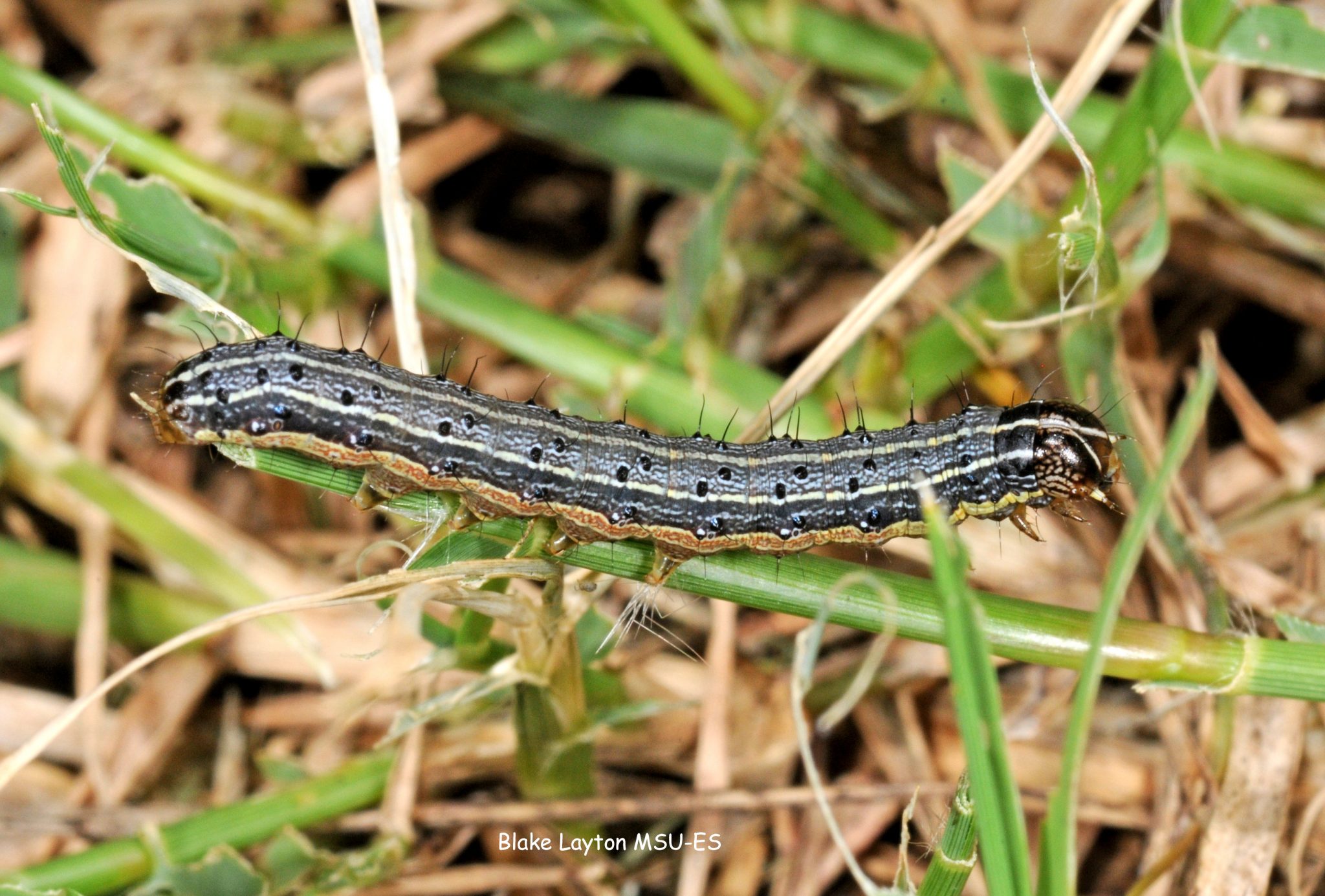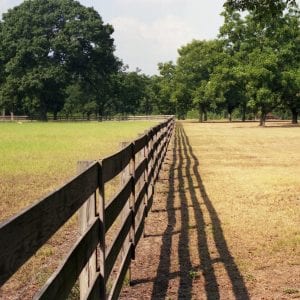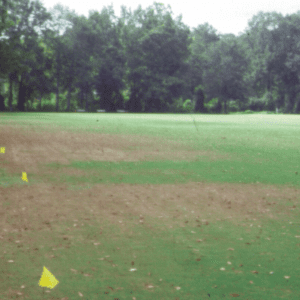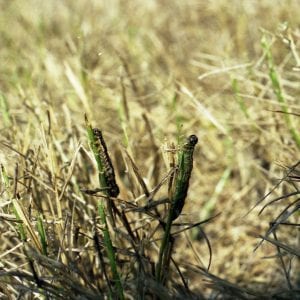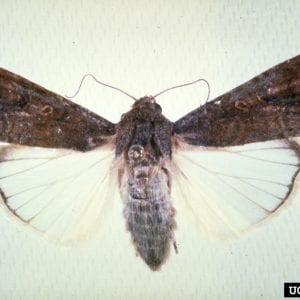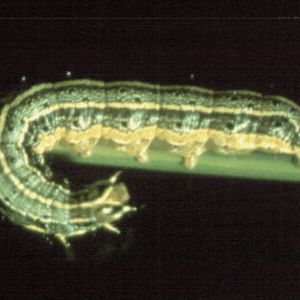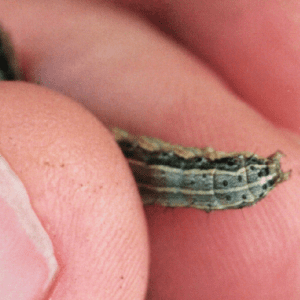Farming

The fall armyworm is a chronic pest in the Southeast and can cause severe damage to grass and forage crops. Damage varies in appearance and severity according to the type of grass and management practices. They are most numerous in late summer or early fall.
The fall armyworm, Spodoptera frugiperda, is a chronic pest in the Southeast. More than 60 plants have been reported as hosts of the fall armyworm, including forage grasses, corn, alfalfa, cotton, soybeans, and most vegetable crops. There are two strains of the fall armyworm, the rice strain and the corn strain. The rice strain caterpillars feed on a variety of forage crops, but seem to prefer lush, green, well-fertilized bermudagrass. Other forage grasses that are hosts for fall armyworm are bahiagrass, pearl millet, sorghum-sudan hybrids, tall fescue, and various winter annuals including ryegrass, rye, wheat, and oats.
Seasonal Occurrence
As the name indicates, fall armyworms are most numerous in late summer or early fall. Usually, reports of fall armyworm damage begin to come in during late July or early August. First reports are usually from southern Alabama. There are three or more generations of fall armyworm each year. Each generation takes about 30 days under Alabama’s summer conditions. Occasionally, severe outbreaks occur as early as mid-April.
Fall armyworms are susceptible to cold and are unable to survive even the mildest winters in Alabama. Each year, fall armyworm moths, carried by air currents, make their way from southern Florida, southern Texas, and Central and South America. The size and timing of the initial moth flights are two factors that influence the outbreak potential of this pest.
Droughty conditions are favorable for the fall armyworm. Fall armyworms can be found up until the first killing frost in an area. However, the risk of damage declines as it gets cooler because the pest develops more slowly in cooler temperatures.
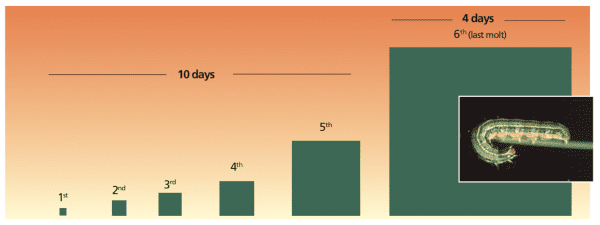
Figure 1. Relative amounts of food eaten by a fall armyworm caterpillar during each growth stage. In summer, a caterpillar feeds for about 14 days, but most of the food is consumed in the last four days.
Behavior Patterns
The fall armyworm is in the same insect family (Noctuidae) as cutworms and other armyworms. Fall armyworm caterpillars damage grass by chewing plant tissue.
Fall armyworms are typically most active early in the morning, late in the afternoon, or in early evening, but on taller, unmowed grass, they can be observed feeding on foliage throughout the day. On closely grazed or recently mowed hayfields, fall armyworm larvae spend the warmer hours of the day deep in the sod.
Fall armyworm damage often seems to appear overnight. Young armyworms don’t eat much. Almost all the damage is caused by the oldest caterpillars, which in four days of feeding, eat more than all the other ages put together (fig. 1). Therefore, an infestation may have been present but not detected because of the small size of the caterpillars.
Another reason for the sudden appearance of this insect is that the larger fall armyworms will sometimes march into (quickly invade) an uninfested area in search of food once an adjacent field has been defoliated (fig. 2). Large armyworms frequently disappear almost as suddenly as they appeared, either burrowing into the ground to pupate or moving on in search of food.
Damage
Fall armyworm damage may vary in appearance and severity according to the type of grass and management practices. In closely grazed fields, the grass may seem to thin out and develop brown spots similar to those sometimes seen on golf courses (fig. 3). These spots look burned or browned out. This appearance is the result of grass plants rapidly dehydrating after fall armyworm larvae have chewed off the tender foliage. For this reason, fall armyworm damage often resembles drought damage.
In hayfields or in pastures, virtually all tender green material may be removed, leaving only tough stems a few inches long protruding from the soil surface (fig. 4). Brown patches appear in the field and can rapidly increase in size.
Established, healthy bermudagrass is rarely killed by fall armyworms, but the complete defoliation caused by a severe infestation weakens plants and deprives livestock of pasture or a hay producer of a hay cutting.
Fall armyworm damage on newly established grasses including winter annuals, tall fescue, or orchardgrass can be an even more serious situation. Seedlings of these fall-seeded plants are small when populations of fall armyworm are at seasonal highs. These crops can be severely stunted or killed if fall armyworms feed too far down on these plants.
Click on images below for full scale.
- Figure 2. Fall armyworms marching from right to left across a pasture completely defoliating the foliage as they move.
- Figure 3. Fall armyworm damage on closely mowed grass. Note brown patches resembling drought damage.
- Figure 4. Fall armyworm damage in a hayfield. Caterpillars have eaten the tender, green portions of the grass, leaving jagged leaf edges and tough leaf bases.
Description and Life Cycle
Adult. The adult fall armyworm is an ash-gray moth with a wingspan of about 11⁄2 inches (fig. 5). The front wings are mottled and have white or light gray spots near the tips. The back wings are white with a narrow, smoky-brown edge. Moths become active at twilight and feed on nectar. They have an average life span of 2 to 3 weeks.
Eggs. The female moths lay eggs at night in masses of several hundred. They prefer to lay eggs on light- colored surfaces such as fence rails, tree trunks, and the underside of tree limbs. They will also lay eggs on the grass itself. Most eggs are laid 4 to 9 days after the female emerges from the pupal stage. The eggs are light gray and covered with grayish fuzz from the female’s body. These masses darken with age, and the eggs hatch within 2 to 4 days. All the eggs within a mass hatch at about the same time.
Larvae (Caterpillars). The tiny, light-colored, black- headed larvae spin down to the ground on silken webs and begin to feed. As they grow, their bodies darken and noticeable stripes appear. When fully grown, larvae may be up to 11⁄2 inches long and vary in color from light green to almost black with several stripes along the body (fig. 6). The “face” is marked with a light-colored inverted Y. Just behind the head, on the back of the caterpillar, you will see three thin white stripes running the length of the next segment. Sometimes these lines extend along the length of the caterpillar, as seen in figure 4. There are usually small dark spots on the top side of each segment of the body. On the next-to-last segment, these spots are arranged like the corner points of a square (fig. 7) Under summer conditions, caterpillars feed for about 14 days and most of the feeding is done in the last four days after the caterpillar molts into its largest size. Development of all stages of the fall armyworm is driven by temperature, so as temperatures cool in autumn it will take longer for the caterpillars to develop. Caterpillars can develop whenever the temperature is above 55 degrees F. It takes about 355 degree-days above this lower temperature threshold for the caterpillars to develop from hatching until they pupate.
Pupae. Fully grown larvae burrow into the soil and form pupae. The moths emerge in about 10 days in summer.
Click on images below for full scale.
- Figure 5. Adult fall armyworm. (Photo credit: B. R. Wiseman, USDA ARS, Bugwood.org.)
- Figure 6. Fully grown fall armyworm larva. Note inverted Y on the head capsule and the three white stripes just behind the head.
- Figure 7. Fully grown fall armyworm larva. Note set of four dots on the end of the abdomen.
Management Tips for Perennial Grass Pastures and Hayfields
Fall armyworm damage is most likely to occur from August through October when populations are at seasonal highs. During periods of drought, it is not uncommon to receive the first reports of damage in July. Natural enemies of the armyworm are less effective during drought years.
Damage from armyworms seems to come in waves about a month apart. This is because moth activity and egg laying peak periodically even though there is substantial overlap between generations. Fields damaged by fall armyworm should be closely monitored for the rest of the season to determine whether further treatment is required.
Because moths prefer light-colored surfaces on which to lay eggs, check these first. In pastures and hayfields, fence rails, fence posts, and tree limbs are favored egg-laying sites.
If a hayfield has been heavily damaged, fertilize as recommended to allow for another hay crop. Badly damaged pastures may need to be rested. If possible, restrict grazing on badly damaged pastures until the grass has regrown.
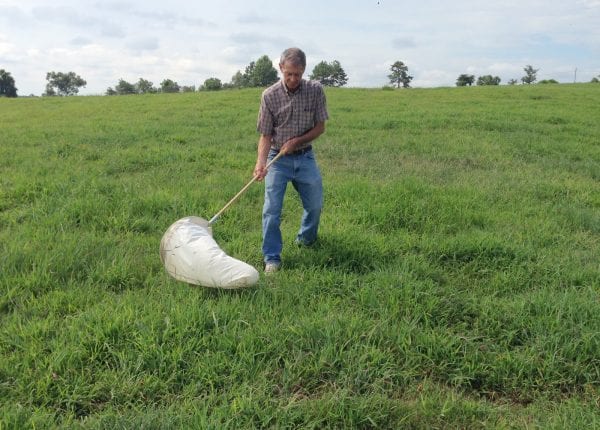
Figure 8. Scouting fields with a sweep net is the best practice to locate fall armyworm infestations early in their life cycle. Sweep the net from side to side and through the foliage to capture specimens.
Scouting. Scouting pastures and hayfields can help detect fall armyworm infestations before they cause economic damage. The best places to start looking for fall armyworms are in your most valuable hayfields as well as in areas of fields that have been attacked by fall armyworms in previous years. The best way to detect fall armyworms is to use an insect net (fig. 8) to sweep the forage grass. A sweep net picks up larvae that are too small to find in any other way (fig. 9). Sweep the grass in early morning or late afternoon to check for the presence of young armyworms. If you find fall armyworms using the sweep net, the next step is to count how many caterpillars you have per square foot. Look on the grass itself as well as in the leaf litter (thatch) on top of the soil. If you find more than two to three caterpillars per square foot, it is probably time to apply an insecticide or to cut the field for hay. You can purchase a sweep net from mail order supply stores that specialize in farm, forestry, or pest management supplies. An insect sweep net costs approximately $25. Regional animal science Extension agents and most county offices of Alabama Extension have sweep nets that can be borrowed to look for armyworms in forages. Find county offices at http://www.aces.edu/directory). A video demonstrating how to use a sweep net to find fall armyworms is available at http://www.aces.edu/go/720.
If you don’t have a sweep net, check in and around areas with dead grass or where birds are congregating. If no caterpillars are seen on the grass, look in the thatch at the base of the plants for larvae and green pellets of frass (larval excrement) about the size of bahiagrass seeds. In fields wet with dew, you can find caterpillars stuck on tires of vehicles that have been driven through an infested field.
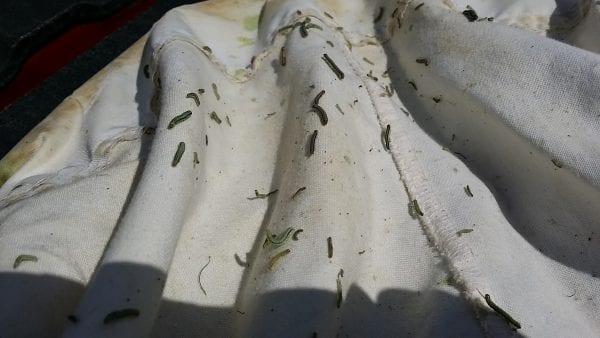
Figure 9. Fall armyworm larvae captured in a sweep net.
Treatment Threshold. The decision to treat for fall armyworms depends on the stage of the armyworms and the intended use of the forage. A population of 2 to 3 or more fall armyworms per square foot is a reasonable treatment threshold. As with other pests, timing is important. If infestations are detected too late, the damage may already have been done.
If necessary, treat with insecticides at the right time. Small fall armyworms are much easier to kill than larger ones. Some products will not control large larvae at all. If you check an area properly, you can determine the extent of an infestation and spot-treat.
Frequently, mowing is the best option for salvaging a hay crop. When this approach is taken, it may be possible to avoid using an insecticide. The harvesting operation kills some caterpillars directly, and others die from exposure to the high soil surface temperatures that occur after harvest. Fall armyworms that survive the harvest operation can continue to feed on the cut hay until it dries down. The caterpillars are most likely to survive if we have relatively cool weather conditions after harvest. The faster hay can be raked and baled, the better. If extremely high numbers of caterpillars are found or cool weather is expected, harvesting alone may not be enough to stop the armyworms.
Insecticidal Control. There are numerous insecticides that can be used for controlling fall armyworm caterpillars in perennial grass forages (table 1). Some, but not all of these, can also be used in annual grass forages. It is important to read the directions for use (the label) of an insecticide carefully to make sure that the product can be applied to a particular type of forage. The label also contains information on how to mix and apply the product for maximum efficacy. Insecticides have two names. Most of us are more familiar with the trade name of the insecticide, because that is the marketing name. However, it is important to be familiar with the insecticide’s common name, or active ingredient, which can be found in the active ingredient section of the product label. The common name is typically written in lowercase letters to distinguish it from the trade name. The same insecticide may be sold under several trade names. The most up-to-date list of what insecticides are registered can be found in Extension publication IPM-0028, Pastures and Forage Crops IPM Guide.
The insecticides vary in price; grazing and harvesting intervals; mode of action; speed of action; and safety to the environment and to the applicator. The insecticide label usually recommends a range of application rates. In general, use higher rates of insecticides (and higher volumes of water) when the grass is thick, when fall armyworm populations are high, when caterpillars are large, and to get the longest residual effect. Some insecticides will kill only smaller caterpillars, so check the comments about each insecticide. Pay close attention to the number of times a particular insecticide can be applied per hay cutting and per season. Within a season, rotate between different modes of action, if possible.
The following generalizations may help you match your circumstances to the right insecticide.
- Insecticides with the shortest interval between last application and when a pasture can be grazed (grazing interval in parentheses): beta- cyfluthrin (0), cyfluthrin (0), chlorantraniliprole (0), diflubenzuron (0), gamma-chylothrin (0), lambda- cyhalothrin (0), methoxyfenozide (0), spinosad (0), and zeta-cypermethrin (0). On the other extreme, carbaryl (Sevin) has a 14-day grazing and harvest restriction.
- Insecticides with the shortest interval between the time of application and harvest (preharvest interval): beta-cyfluthrin (0), cyfluthrin (0), chlorantraniliprole (0), zeta-cypermethrin (0), diflubenzuron (1), methomyl (3), and spinosad (3).
-
Insecticides with the longest residual: methoxyfenozide, diflubenzuron, and chlorantraniliprole. Insecticides with longer residuals help in outbreak years when generations of fall armyworms overlap, resulting in almost continuous egg laying. Caterpillars sprayed with methoxyfenozide or chlorantraniliprole quickly stop eating, become paralyzed, and then die within a few days. Caterpillars sprayed with diflubenzuron do NOT stop eating until the next time they molt. That is why it is essential that diflubenzuron be applied when the fall armyworm caterpillars are 1⁄2 inch long or less, well before they get to their last molt. Remember that about 80 percent of the total feeding is done after the last molt, in the last four days of the caterpillar stage.
- Insecticides that do not require a pesticide applicators license: carbaryl, chlorantraniliprole, methoxyfenozide, and spinosad.
Additional Information
More information is available from your county Extension office. Visit www.aces.edu/directory.
Tips for Application of Insecticides
- Apply insecticides early or late in the day, because the caterpillars are more active at these times.
- Use as large a spray volume as you can (20 gallons by ground or 3 to 5 by air, if possible).
- Never apply the insecticide in less water than is recommended on the label.
- Scout for armyworms because you may find that you don’t have to treat the whole of each field.
- Apply insecticides where you find the caterpillars.
-
Stop the advance of caterpillars marching into a field by applying several swaths of the insecticide on either side of the front line.
- Find the caterpillars when they are small so you can save money by using a lower rate of the insecticide.
Table 1. Suggestions for Control of Fall Armyworm in Perennial Grass Pastures and Hayfields
1 Amounts listed are for the amount of active ingredient, indicated by "ai" as well as for the amount of the actual formulated product listed by trade name.
2 See label for minimum retreatment intervals as well as maximum amounts that can be applied per cutting and per season.
3 Signal words describe the acute (short-term) toxicity of the product. Products with no signal word or with the wordcaution are the lowest in toxicity.
4 MoA Group: insecticides kill insects in various ways. Insecticides in the same MoA group kill insects in the same way. If there are concerns about insecticide resistance, choosing an insecticide in a different MoA group is recommended.
5 Other products containing this active ingredient may be available.
| Insecticide, Trade Name, and MoA Group | Rate1 | Applications Per Cutting of Hay2 | Minimum Days from Last Application to Harvest (h) or Grazing (g) | Comments, Signal Word, Use Restrictions3 |
|---|---|---|---|---|
| beta-cyfluthrin BAYTHROID XL MoA Group 3A4 | 0.02–0.022 lb. ai/A 2.6– 2.8 fl. oz./A | 1 every 5 days, maximum of 4 per cutting | 0 | For first and second instar armyworms. Warning, RESTRICTED USE |
| carbaryl5 SEVIN XLR Plus MoA Group 1A | 1–1.5 lb. ai/A 1–1.5 qt./A | 2-3 | 14 | Caution |
| chlorantraniliprole5 PREVATHON MoA Group 28 | 0.047–0.067 lb. ai/A 14–20 fl. oz./A | 1 every 7 days, maximum of 4 | 0 | Larvae become paralyzed soon after eating the foliage then die in 1 to 3 days. |
| cyfluthrin5 TOMBSTONE MoA Group 3A | 0.025–0.03 lb. ai/A 1.6–2.8 fl. oz./A | 1 every 5 days, maximum of 4 per cutting | 0 | For first and second instar armyworms Warning, RESTRICTED USE |
| diflubenzuron5 DIMILIN 2L MoA Group 15 | 0.03 lb. ai/A 2 fl. oz./A | 1 | 1 (h), not specified (g) | Apply before armyworms are 1⁄2 inch long because caterpillars keep eating until their next molt. For maximum control, apply at first sign of egg hatch. Caution, RESTRICTED USE |
| gamma-cyhalothrin DECLARE MoA Group 3A | 0.01–0.015 lb. ai/A 1.02–1.54 fl. oz./A | 1 | 7 (hay), 0(g) | Use higher rate for heavy populations, larger caterpillars, or dense foliage. Warning, RESTRICTED USE |
| lambda-cyhalothrin5 WARRIOR II WITH ZEON MoA Group 3A | 0.02–0.03 lb. ai/A 1.28–1.92 fl. oz./A | 1 | 7 (hay), 0 (g) | Use higher rate for heavy populations, larger caterpillars, or dense foliage. Warning, RESTRICTED USE |
| lambda-cyhalothrin + chlorantraniliprole BESIEGE MoA Group 3A + 28 | 0.02–0.03 lb. ai/A + 0.04–0.06 lb. ai/A 6–10 fl. oz./A | 1 | 7 (hay), 0 (g) | Use higher rate for heavy populations, larger larvae, or dense foliage. Warning, RESTRICTED USE |
| methomyl5 LANNATE LV 2.4 MoA Group 1A | 0.22–0.9 lb. ai/A 0.75–3 pt./A | 1–4 | 3 (hay), 7 (g) | Use higher rate for heavy populations and larger larvae. User lower rate for small larvae. FOR BERMUDAGRASS ONLY. Danger/Poison, RESTRICTED USE |
| methoxyfenozide5 INTREPID 2F MoA Group 18 | 0.06–0.12 lb. ai/A 4–8 fl. oz./A | 1 | 7 (hay), 0 (g) | Comments, Signal Word, Use Restrictions3 Caution For first and second instar armyworms Warning, RESTRICTED USE Use higher rate for heavy populations, larger caterpillars, or dense foliage. Warning, RESTRICTED USE Use higher rate for heavy populations, larger larvae, or dense foliage. Warning, RESTRICTED USE Use a higher rate for heavier infestations or where thorough coverage is difficult. Larvae stop feeding almost immediately but may take several days to die. Caution |
| spinosad5 BLACKHAWK MoA Group 5 | 0.024–0.05 lb. ai/A 1.1– 2.2 oz./A | Do not apply more than 3 times in a 21-day period. | 3 (h), 0 (g) | Do not allow cattle to graze until foliage has dried. Use higher rate for heavy populations and larger caterpillars. Caution |
| zeta-cypermethrin MUSTANG MAXX INSECTICIDE MoA Group 3A | 0.017–0.025 lb. ai/A 2.8–4.0 fl. oz./A | 1 | 0 | Use higher rate for heavy populations and larger caterpillars. Graze when spray is dry. Warning, RESTRICTED USE |
Download a PDF of Management of Fall Armyworm in Pastures and Hayfields, ANR-1019
Use pesticides only according to the directions on the label. Follow all directions, precautions, and restrictions that are listed. Do not use pesticides on plants that are not listed on the label.
The pesticide rates in this publication are recommended only if they are registered with the Environmental Protection Agency and the Alabama Department of Agriculture and Industries. If a registration is changed or canceled, the rate listed here is no longer recommended. Before you apply any pesticide, check with your county Extension agent for the latest information.
Trade names are used only to give specific information. The Alabama Cooperative Extension System does not endorse or guarantee any product and does not recommend one product instead of another that might be similar.

